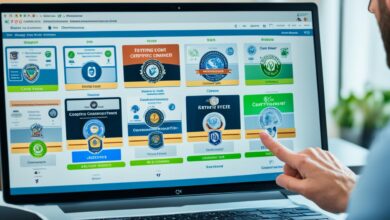Empowering Growth: Professional Development for Teachers

When it comes to ensuring student success, who plays a crucial role in shaping the future? Is it the curriculum? The resources? The infrastructure? Well, it’s none other than the teachers themselves. As educators, their growth and development directly impact the quality of education and the outcomes of their students. But here’s the question: have we truly recognized the power of professional development for teachers?
In this article, we delve into the world of professional development for teachers and explore its immense value in empowering growth and igniting positive change. From transformative teacher training programs to engaging teaching workshops and instructional coaching sessions, we will uncover an array of opportunities for educators to refine their skills and expand their knowledge.
Join us on this journey as we challenge common beliefs, bust misconceptions, and shed light on the undeniable impact of professional development for teachers. Get ready to discover a treasure trove of resources, strategies, and insights that will revolutionize the way we think about teacher growth and student success.
Key Takeaways:
- Professional development is essential for teacher growth and career advancement.
- There are various programs and opportunities available for teachers to enhance their skills and knowledge.
- A supportive learning environment and continuous improvement culture are crucial for effective professional development.
- Technology and inclusive practices play significant roles in professional development for teachers.
- Measuring student learning and success through professional development drives instructional decisions.
The Impact of Teacher Empowerment on Student Success
Research has consistently shown that teacher empowerment plays a crucial role in determining student success. When teachers feel empowered in their roles and have a sense of agency, it positively influences their efficacy and autonomy, ultimately benefiting their students.
Teacher empowerment encompasses a range of factors, including the ability to make instructional decisions, collaborate with colleagues, and contribute to school policies and practices. This empowerment fosters a sense of ownership and responsibility among teachers, leading to a more engaging and effective learning environment.
Studies have demonstrated that when teachers have a high level of efficacy, or belief in their ability to influence student learning, they are more likely to employ effective instructional strategies, set high expectations, and provide personalized support. This, in turn, significantly impacts student outcomes and academic performance.
Furthermore, teacher autonomy is closely linked to student success. When teachers have the freedom to tailor their teaching methods to meet the needs of their students, they can apply best practices, adapt curriculum materials, and provide differentiated instruction. This individualized approach contributes to increased student engagement, motivation, and achievement.
“In order to create a positive learning environment and improve student achievement, schools must prioritize teacher empowerment. By fostering a culture of autonomy and efficacy, educators can make a profound difference in the lives of their students.”
– Dr. Sarah Johnson, Education Researcher
Empowering teachers not only benefits students academically but also enhances their socio-emotional development. When educators feel supported and empowered, they can better address the diverse needs of their students, create a more inclusive and welcoming classroom environment, and build positive relationships that foster student well-being.
As schools recognize the powerful impact of teacher empowerment on student success, they are increasingly investing in professional development programs that promote teacher autonomy, efficacy, and growth. These programs provide educators with the necessary knowledge, skills, and resources to effectively empower their teaching practices and positively impact student outcomes.
By prioritizing teacher empowerment, schools can create a transformative learning environment where students thrive academically, socially, and emotionally. When teachers feel empowered to guide their students toward success, everyone in the educational ecosystem benefits.
Supporting Teacher Growth through Professional Development
Professional development plays a crucial role in supporting and nurturing teacher growth. By providing teachers with the necessary opportunities and resources, schools can empower educators to enhance their instructional practices and make a positive impact on student learning.
One key aspect of supporting teacher growth is through goal-setting conversations. These conversations allow teachers to reflect on their current practices, identify areas for improvement, and set meaningful goals for their professional development. By engaging in goal-setting conversations, teachers can focus their efforts on specific areas that will have the greatest impact on their teaching.
Another important way to support teacher growth is by offering targeted training opportunities. These opportunities provide teachers with the knowledge and skills they need to excel in their roles. By tailoring professional development to address specific areas of need, schools can ensure that teachers receive training that aligns with their goals and aspirations.
“Professional development is not a one-size-fits-all approach. It should be tailored to meet the unique needs and goals of individual teachers.” – Sarah Johnson, Education Consultant
Furthermore, schools can support teacher growth by creating a culture that values ongoing learning and collaboration. By fostering an environment where teachers feel encouraged to share ideas, collaborate with their peers, and learn from one another, schools can create a community of educators dedicated to continuous improvement.
To visually highlight the importance of supporting teacher growth through professional development, let’s take a look at the following table:
| Benefits of Professional Development | |
|---|---|
| Teacher Growth | Enhanced instructional practices |
| Increased knowledge and skills | |
| Improved confidence and self-efficacy | |
| Student Learning | Increased engagement and motivation |
| Higher academic achievement | |
| Differentiated instruction to meet diverse learning needs |
By investing in the development of teachers through professional development opportunities, schools can create a supportive and enriching environment that benefits both teachers and students alike. The growth and success of teachers directly correlate to improved instructional practices and enhanced student learning outcomes.
Next, let’s explore the importance of creating a culture of continuous improvement in Section 4.
Creating a Culture of Continuous Improvement
In today’s rapidly evolving educational landscape, it is crucial for schools to foster a culture of continuous improvement. This means embracing a mindset of growth and innovation, where teachers are encouraged to reflect on their practices, engage in self-assessment, and seek feedback from peers. By prioritizing reflection, self-assessment, and peer observation and feedback, schools can drive positive change and enhance the overall learning experience.
Culture of Continuous Improvement
A culture of continuous improvement refers to the collective mindset and values within a school community that promotes ongoing growth and learning. It is a commitment to never settle for mediocrity but instead to constantly strive for excellence. By creating such a culture, schools empower their teachers to take ownership of their professional development and continuously refine their instructional practices.
Reflection and self-assessment play a pivotal role in this process. Teachers who engage in regular reflection on their teaching strategies, classroom management techniques, and assessment practices can identify areas for improvement and implement targeted changes. Through self-assessment, educators can develop a deeper understanding of their strengths and areas that need enhancement, setting the stage for growth and progress.
“Reflective practices enable teachers to identify areas of strength and areas for improvement, leading to enhanced instructional practices and improved student learning outcomes.”
Peer Observation and Feedback
Peer observation and feedback are also powerful tools for promoting continuous improvement in schools. By observing their colleagues’ classrooms, teachers can gain valuable insights into alternative teaching methods, classroom management strategies, and student engagement techniques. This exposure to different perspectives and approaches can inspire teachers to explore new strategies and adapt their instructional practices.
Moreover, feedback from peers provides teachers with a fresh perspective on their teaching, helping them to identify blind spots and areas for growth. Constructive feedback allows teachers to refine their approaches and make informed instructional decisions that positively impact student learning.
Fostering Innovation and Enhancing the Learning Experience
By fostering a culture of continuous improvement, schools not only empower teachers but also drive innovation and enhance the overall learning experience for students. Cultivating an environment that values reflection, self-assessment, and peer observation and feedback encourages educators to explore new teaching strategies, leverage technology, and embrace evidence-based practices.
The result is a dynamic educational ecosystem where educators continuously seek ways to improve their instructional practices, meet the diverse needs of their students, and constantly innovate in the pursuit of educational excellence.
As schools embrace the culture of continuous improvement, they position themselves for long-term success, ensuring that they remain at the forefront of educational innovation and deliver high-quality instruction to their students.
Empowering Teachers as Leaders
In today’s educational landscape, teachers play a crucial role not only in the classroom but also as leaders within the school community. Developing teacher leadership skills is a key component of fostering a collaborative and effective education system. When empowered to lead, teachers can make a significant impact on student success and school improvement.
One way to empower teachers as leaders is by establishing teacher-led teams. These teams allow educators to collaborate, share ideas, and collectively make decisions that directly impact teaching and learning. By involving teachers in the decision-making process, schools promote a sense of ownership and foster a culture of collective responsibility.
“Teacher-led teams provide a platform for collaboration, innovation, and professional growth, ultimately enhancing the overall effectiveness of the education system.” – Dr. Jane Thompson, Education Consultant
Shared decision-making is a powerful approach that values the expertise and perspectives of teachers. It recognizes that those on the frontlines of education possess invaluable insights and knowledge that can drive meaningful change. By actively involving teachers in important decisions related to curriculum, instructional strategies, and school policies, schools can tap into their expertise and create an environment that is responsive to the needs of both educators and students.
Benefits of Empowering Teachers as Leaders:
- Enhanced collaboration among educators
- Increased ownership and job satisfaction
- Improved instructional practices
- Alignment of school goals with classroom realities
- Greater focus on student success
When teachers are given opportunities to lead and influence change, they become more invested in their professional growth and the success of their students. Teacher leadership skills such as communication, problem-solving, and collaboration are not only essential for driving school improvement but also contribute to the personal development and career advancement of educators.
Teacher Leadership in Action
Take the example of Jefferson High School, where a team of teachers initiated a school-wide literacy program. Recognizing the importance of literacy skills for student success across all subjects, this team developed curriculum resources, provided professional development workshops for their colleagues, and led ongoing data analysis to monitor student progress. As a result, students at Jefferson High School showed significant improvement in both their reading and writing abilities.
By empowering teachers as leaders, schools create an environment that encourages collaboration, fosters innovation, and ultimately improves student outcomes. Recognizing the unique expertise and contributions of teachers is key to enhancing the effectiveness and success of our education system.
The Role of Technology in Professional Development
Rapid advancements in technology have transformed the field of education, offering new opportunities for teachers to enhance their professional development. Integrating technology into professional development programs has become essential in equipping educators with the necessary skills and knowledge to navigate the ever-evolving digital landscape.
One of the key aspects of technology integration in professional development is the use of educational tools. These tools provide teachers with interactive and engaging resources that can be used to create dynamic learning experiences for students. From online learning platforms to educational apps and software, these tools offer a wide range of possibilities to support teaching and learning.
However, it is crucial to remember that technology is just a tool. To effectively utilize technology in the classroom, proper training on technology usage is essential. Teachers need to develop a solid understanding of how to integrate technology into their instructional practices and make the most of the available resources.
Training on technology usage can take various forms, including workshops, webinars, and online courses. These training sessions provide educators with hands-on experience, allowing them to explore different technologies and learn best practices for implementation. Through these opportunities, teachers can develop their technological proficiency, enabling them to leverage technology to enhance their instructional strategies.
By embracing technology in professional development, teachers can transform their classrooms into interactive and collaborative learning environments. Technology integration allows for personalized learning experiences, enabling educators to tailor instruction to meet the unique needs of their students. Through the use of educational tools and effective training on technology usage, teachers can empower themselves to stay at the forefront of educational innovation.
Technology integration in professional development is not about replacing traditional teaching methods; it’s about enhancing them. It’s about equipping teachers with the necessary skills and knowledge to leverage technology as a powerful tool for student engagement and learning.”
Furthermore, technology integration in professional development is not limited to the teachers themselves. School leaders and administrators must also prioritize training and support for educators in adopting and implementing technology effectively. By fostering a culture that values technology integration and providing ongoing training and resources, schools can create an environment that promotes continuous growth and learning.
As the education landscape continues to evolve, it is crucial for teachers to stay abreast of the latest technological advancements. By embracing technology in professional development and providing training on technology usage, educators can enhance their instructional practices, engage students in meaningful ways, and prepare them for success in the digital age.
With the role of technology expanding rapidly in education, it is imperative for teachers to adapt and embrace these advancements. By integrating technology into their professional development journey, educators can unlock new possibilities and empower themselves to create engaging and impactful learning experiences for their students.
Addressing Diverse Learning Needs through Professional Development
In today’s diverse classrooms, teachers face the challenge of addressing the unique learning needs of every student. Professional development plays a crucial role in equipping teachers with the necessary skills and strategies to meet these diverse needs effectively.
One key approach to supporting diverse learners is differentiated instruction. This instructional method recognizes that students have different strengths, abilities, and learning styles. By tailoring instruction to meet individual needs, teachers can engage students at their level and promote meaningful learning experiences.
Inclusive practices are another essential aspect of addressing diverse learning needs. Inclusion involves creating a supportive and accepting classroom environment where all students feel valued and included. Teachers can incorporate inclusive practices by providing accommodations, modifying materials, and fostering a sense of belonging and community.
| Benefits of Addressing Diverse Learning Needs through Professional Development | Strategies for Differentiated Instruction and Inclusive Practices |
|---|---|
|
|
Inclusive classrooms embrace diversity and nurture the potential of every learner. Professional development empowers teachers with the tools and strategies needed to create inclusive learning environments that support the success of all students.
By investing in professional development programs that focus on diverse learning needs, schools can foster an inclusive and supportive learning environment. Through ongoing training, educators can continuously refine their instructional practices, adapt to the changing needs of their students, and ensure that all learners have equitable access to quality education.
To learn more about best practices for implementing professional development programs that address diverse learning needs, click here.
Measuring Student Learning and Success through Professional Development
Professional development plays a crucial role in helping teachers measure student learning and ensure their success in the classroom. By equipping educators with data-driven strategies, they are able to make informed instructional decisions that positively impact student outcomes.
Data-driven strategies provide teachers with valuable insights into student performance and progress. Through ongoing professional development opportunities, educators learn to collect and analyze data to assess student learning. They are able to identify areas of strength and areas that require additional support, allowing them to tailor their instruction to meet individual student needs.
One effective data-driven strategy is the use of formative assessments. These assessments provide teachers with real-time feedback on student understanding and allow for timely instructional interventions. By utilizing formative assessments, teachers can continuously monitor student progress and make necessary adjustments to their teaching methods.
Another essential component of measuring student learning is the ability to interpret and use assessment results. Professional development programs equip teachers with the tools and knowledge needed to effectively analyze assessment data and translate it into actionable insights. With this information, teachers can make data-informed instructional decisions that maximize student growth.
Instructional decisions guided by data not only benefit individual students, but also contribute to a positive learning environment. When teachers have access to accurate and meaningful data, they are better equipped to create targeted instructional plans that address the diverse learning needs of their students.
A study conducted by researchers at the University of Melbourne highlights the importance of data-driven instructional decisions. It found that when teachers use data to inform their teaching practices, student achievement significantly improves across all subject areas.
“Data-driven instructional decision-making allows teachers to provide effective and personalized instruction to meet the diverse learning needs of their students.”
By continuously improving their teaching practices through professional development, teachers have the knowledge and skills to help students reach their full potential. Data-driven strategies enable educators to measure student learning and success, making a lasting impact on student achievement.
The Benefits of Data-Driven Instructional Decisions
| Benefits | Description |
|---|---|
| Personalized Instruction | Data-driven strategies allow teachers to tailor instruction to meet individual student needs, promoting personalized learning experiences. |
| Targeted Interventions | By analyzing data, teachers can identify students who require additional support and provide timely interventions to address their specific learning needs. |
| Improved Student Outcomes | Using data to inform instructional decisions results in improved student achievement and academic growth. |
| Evidence-Based Practices | Data-driven strategies provide educators with evidence-based practices that have been proven to be effective in promoting student learning and success. |
Through professional development, teachers gain the skills and knowledge to effectively measure student learning and success. By implementing data-driven strategies, they can make informed instructional decisions that positively impact student outcomes and create a positive learning environment.
Conclusion
Throughout this article, we have explored the significance of professional development for teachers and its impact on teacher growth and student success. By investing in professional development opportunities, schools can empower their teachers and enhance the overall quality of education.
Professional development for teachers plays a crucial role in fostering their growth and improving their instructional practices. It provides educators with the necessary knowledge, skills, and strategies to meet diverse learning needs, integrate technology effectively, and create a culture of continuous improvement.
By prioritizing professional development, schools can ensure that teachers stay current with the latest research and best practices in education. This, in turn, leads to more effective teaching strategies, improved student outcomes, and a positive learning environment.
In conclusion, professional development for teachers is not only essential for individual growth but also for the success of students. By supporting and investing in professional development opportunities, schools can empower their teachers to make a significant impact on student learning and achievement.







